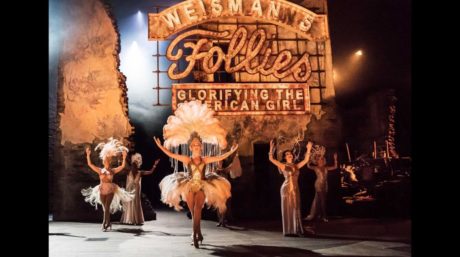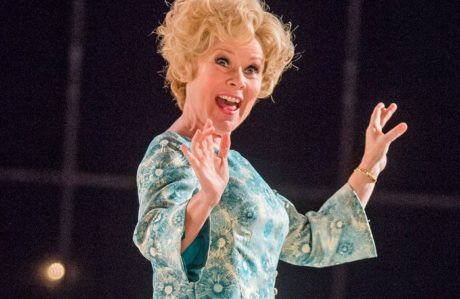I was most anxious to see Follies in its current production at the National Theatre in London. Somehow news of it had escaped me, but Imelda Staunton is a great favorite of mine, and she’s in it, so I was disappointed to be unable to arrange seats on my own, or through any of my London sources. I was taught “it never hurts to ask” as a child, so I marched myself across the Waterloo Bridge to the National itself, on my final day in London, Friday, October 29. The box office gent confirmed that nothing was available for that night, but he said cancellations often occurred and if I cared to return at 6 p.m. he’d know if he had one for me. I returned at 5:30, chatted with the other three hopefuls, and at 6:00 I had my seats! Eighth-row center orchestra (stalls) which gave promise to a perfect ending to my London visit.

The National Theatre is large — a very wide space that accommodates almost 1,200 seats, nicely tiered, acoustically excellent. Director Dominic Cooke, choreographer Bill Deamer, and designer Vicki Mortimer have, with what looks like a limitless budget, filled that space with color and fluidity and size that result in the finest collaboration on this work of Stephen Sondheim, James Goldman, and Hal Prince that’s ever been seen.
As the theater’s space spins before us, the ghost-like figures of the “beautiful girls” that Dimitri Weismann glorified saunter on and off, moving as though on air, lightly and seductively. The music announces the arrival of the guests, who include the party’s host, ex-Weismann girls Sally Durant and Phyllis Rogers, and their husbands Buddy Plummer and Benjamin Stone. They and all the other performers from the past are here to celebrate and remember one last time, before the theater itself will be destroyed to make room for an office complex.
The evening will be full of reminiscence, and we will move from the present to the distant past when Sally and Phyllis, full of youthful vigor, are pursued by their future husbands, as the young men wait anxiously for “the girls upstairs” to come down from their dressing room to join them on a double date.
As the story unfolds, it might seem to be something of a soap opera tale asking, “Can a girl from an ordinary background find romantic fulfillment, adventure, and surprise all in one relationship?”
The score by Sondheim gives complexity and dimension to these four central characters, and opportunity to other gifted actors to deliver memorable moments to us. Along the way, time is taken to give others a chance to tell us how much they crave to “be in a show,” that they are “still here,” to recall more deceptively romantic times by begging for “one more kiss.”

There will be the tearing away of denial and repression for Sally in “In Buddy’s Eyes” and “Losing My Mind,” for Phyllis in “Could I Leave You?” and “The Story of Lucy and Jessie,” for Buddy and Ben in “The Right Girl,” and “Too Many Mornings.” Back and forth we go, from this night of celebration to the inner workings of their minds as a fantasy Follies is created for us in “Loveland,” in which hidden demons are dealt with. It’s all about the highs and lows of even average lives, spoon-fed to us in two dozen musical numbers that put Sondheim at the head of the list of contemporary writers for musical theater.
The National Theatre has assembled a cast to tell this story that is pitch perfect. Imelda Staunton is stunning as drab little insecure Sally Durant Plummer who wanted so badly to marry a man she couldn’t have, only to realize she’d have to settle for one who wanted her more than she wanted him. Janie Dee is tall, imperious, regal, and cold — a dazzling creature for Ben Stone to have on his arm for a lifetime. There is an aspect to this woman that is totally unsatisfied, and Ms. Dee shows it to us in her breathtaking turn in answering Ben’s question: “Why don’t you leave me?” The scene that precedes it is James Goldman and Stephen Sondheim at their finest, and the conclusion is devastatingly effective.
Tracie Bennett, Di Botcher, Geraldine Fitzgerald, Josephine Barstow, Dawn Hope, and Adrian Grove are all troupers of the first order and each of them brings to vivid life their unique example of theatrical personality who clearly delights in entertaining us.
With all respect to the original team that first breathed life into this marvelous work — and that includes the authors and the remarkable Hal Prince and Michael Bennett who first directed and choreographed it — the team that has put it together at the National has used it as a springboard from which to mount this larger, more spectacular, and very moving present version. It served well to complete my wonderful London week much as a cherry does sitting on top of a delicious chocolate cake.
Running Time: 2 hours 10 minutes with no intermission.
Follies plays through January 3, 2018, at the National Theatre’s Olivier Theatre – South Bank, London SE1 9PX. For tickets, purchase them online.





